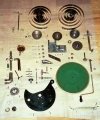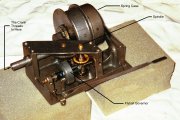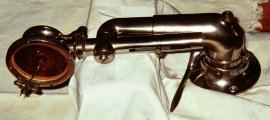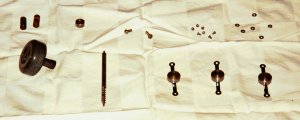John Dowding's Brunswick Gramophone
Back to Mechanical
and Electrical Main Page
Home
 |
 |
 |
 |
 |
| 1. Close Up |
2. All the Parts |
3. Spring Motor (shown inverted) |
4. Tone Arm After Partial Restoration |
5. Flyball Governor |
This Brunswick floor model had a broken spring (since most of these
units are 80 or more years old, this is not an uncommon problem). My great
uncle purchased it new and for 50 years, he very rarely used it. When he
passed away in the early 1970's my father inherited it and we played old
78's on it till one of its two springs broke. It sat at my parents house
as a display piece till late 2000 when they gave it to me. In early 2001,
I completely dismantled the spring motor, cleaned it up, replaced the broken
spring and re-assembled it. It's working fine now and from time to time,
I play a recording or two. These machines are truly works of art and engineering.
The wonderful tone you get from a completely mechanical sound system is
something special to hear.
The above pictures (links to larger JPEGs) are just a sample of those
I took while I was involved in the restoration project.
-
Larger view of the unit before restoration began. Notice the unpolished
tone arm.
-
In the "All the Parts" picture, I laid out everything that makes this thing
work. All the nuts, bolts, springs, gears, platter, the cast iron baseplate
and even a few playing needles are visible in this picture.
-
The spring motor makes it all happen. This is like a more powerful version
of the wind-up motor in a toy car but with a fairly accurate speed control
unit that's called a flyball governor (see 5 below).
-
The tone arm is to sound what the spring motor is to making the record
turn, and the reproducer (head) is where movement gets turned into sound.
When the record vibrates the needle back and forth, the diaphragm in the
head is moved in and out. It's difficult to see the diaphragm in the picture
because it's made of mica which is clear. This in and out motion produces
a continually varying pressure wave inside the reproducer which then travels
down the tone arm to the acoustic horn (this is the big metal horn generally
associated with gramophones, but in floor models it is usually made of
wood and enclosed inside the cabinet - the grill can be seen at the bottom
of picture 1 above). You can see from the condition of the rubber rings
that hold the diaphragm in place that I didn't remove them. This is because
the mica is very delicate and I didn't have a replacement diaphragm in
case I damaged it. When I get a replacement diaphragm and rubber gasket
material, I will attempt this work. More pliable rubber will improve the
sound a bit but it's not worth the risk of damaging the existing materials.
-
The flyball governor is the speed controller for the spindle motor. When
I was a child, my father taught me how these things work and it really
fascinated me. The three small flyweights have spring-steel strips (flexures)
which are fixed to a shaft at one end, and at the other end, to a brake
disc that can slide along the shaft. These flexures are designed to bring
the flyweights close to the shaft when it isn't rotating. The whole setup
rotates with the shaft and as it picks up speed, the weights tend to fly
outward pulling the brake disc along the shaft and eventually bringing
it into contact with a brake shoe. This causes a bit of friction, enough
to slow the speed slightly. As that happens, the weights fall back inward
causing the disc to move away from the shoe and the shaft is free to pick
up speed again. This might seem to make the speed go up and down but in
reality what happens is that the speed stabilizes at an equilibrium value.
The speed can be adjusted by moving the position of the brake shoe slightly
closer to or further from the rest position of the brake disc and gramophones
usually have an adjustment knob which serves this purpose. Notice on this
Brunswick model, that it doesn't have a disc but what looks like the top
of a bicycle bell. This is their solution to a common problem that these
governors had. A flexure could either break or come off one end releasing
the flyweight. At the speed the governor rotates, a flyweight would flail
around, wreaking havoc inside the motor (assuming the other end of the
flexure was still attached). The bell-shaped housing that Brunswick used
was to help contain the flyweights in these situations.
If you have any comments or questions, please contact me at johngdguard-web@yahoo.ca.
Back to Mechanical
and Electrical Main Page
Home









